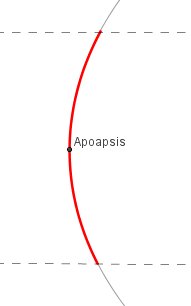I've searched high and low and I haven't been able to find a formula for this.
I'm trying to calculate the time it will take to transit through a defined arc length of an elliptical orbit, whose start and end points are equidistant from a predefined point:
I already have the arc length, and I know how to find my instantaneous velocity at any point along the orbit. What I don't know is how to calculate the time it will take to complete that arc length, since the object will be constantly changing velocity through the transit.
Can I just take an average of my velocities at the start, end, and midpoint of the arc? The start and end points should be the same value, right?
Say my velocity is 9900m/s at the start of my arc, 10100m/s at periapsis, and 9900m/s again at the end of the arc. Can I just divide the length of the arc by the average of those velocities to get the transit time, or will it be more complicated?
UPDATE: I think I've solved the problem using simple geometry! I realize this would be easier with calculus, but I haven't learned it yet, so for now, I'll stick to this solution.
Here's a gif of the calculator in action: https://gfycat.com/GleefulSaneHypacrosaurus
I went with Kepler's second law, as per the answer @rob suggested. But I had to do a little trick, because I couldn't figure out how to calculate the area of the arc sector from a focus and Geogebra only lets you find the area of a sector from the center.
So, I made a triangle from the center to each end point of the arc, and subtracted that area from the area of the arc sector including the curved section, so that I only ended up with the area of the curved section.
After that, I just add the area of the curved section to the area of a triangle from the focus occupied by the planet to the two end points of the arc to get the total area swept out during that section of orbit.
Then I went ahead and divided the total area of the ellipse by the area of that sector.
Finally, I took the total orbital period, and divided that by the number returned from the previous step. This gives a number in seconds that looks reasonable, and returns correct values when the eccentricity is very close to 0.
But, I'm only about 99.99% sure it's correct. Can anybody confirm my results? I really appreciate everybody's help, but again, calculus is just a bit over my head right now.


